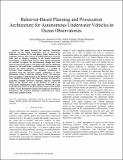Behavior-based planning and prosecution architecture for Autonomous Underwater Vehicles in Ocean Observatories
Author(s)
Balasuriya, Arjuna Prabhath; Petillo, Stephanie Marie; Schmidt, Henrik; Benjamin, Michael
DownloadBalasuriya_etal_IEEE_OCEANS_2010_Sydney.pdf (1.007Mb)
OPEN_ACCESS_POLICY
Open Access Policy
Creative Commons Attribution-Noncommercial-Share Alike
Terms of use
Metadata
Show full item recordAbstract
This paper discusses the autonomy framework proposed for the mobile instruments such as Autonomous Underwater Vehicles (AUVs) and gliders. Paper focuses on the challenges faced by these clusters of mobile platform in executive tasks such as adaptive sampling in the hostile underwater environment. Collaborations between these mobile instruments are essential to capture the environmental changes and track them for time-series analysis. This paper looks into the challenges imposed by the underwater communication infrastructure and presents the nested autonomy architecture as a solution to overcome these challenges. The autonomy architecture is separated from the low-level control architecture of these instruments, which is called the `backseat driver'. The back-seat driver paradigm is implemented on the Mission Oriented Object Suite (MOOS) developed at MIT. The autonomy is achieved by generating multiple behaviors (multiple objective functions) linked to the internal state of the platform as well as the environment. Optimization engine called the MOOS-IvP is used to pick the best action for the given instance based on the mission at hand. At sea operational scenarios and results are presented to demonstrate the proposed autonomy architecture for Ocean Observatory Initiative (OOI). Keywords: Autonomous Underwater Vehicles (AUVs), Underwater
Gliders, MOOS, MOOS DB, MOOS-IvP, OOI-CI, behavior-based
autonomy
Date issued
2010-10Department
Massachusetts Institute of Technology. Department of Mechanical EngineeringJournal
OCEANS'10 IEEE SYDNEY
Publisher
Institute of Electrical and Electronics Engineers (IEEE)
Citation
Balasuriya, Arjuna, Stephanie Petillo, Henrik Schmidt, and Michael Benjamin. “Behavior-Based Planning and Prosecution Architecture for Autonomous Underwater Vehicles in Ocean Observatories.” OCEANS’10 IEEE SYDNEY, 24-27 October, 2010. Sydney, NSW, Australia, IEEE, 2010.
Version: Author's final manuscript
ISBN
978-1-4244-5221-7